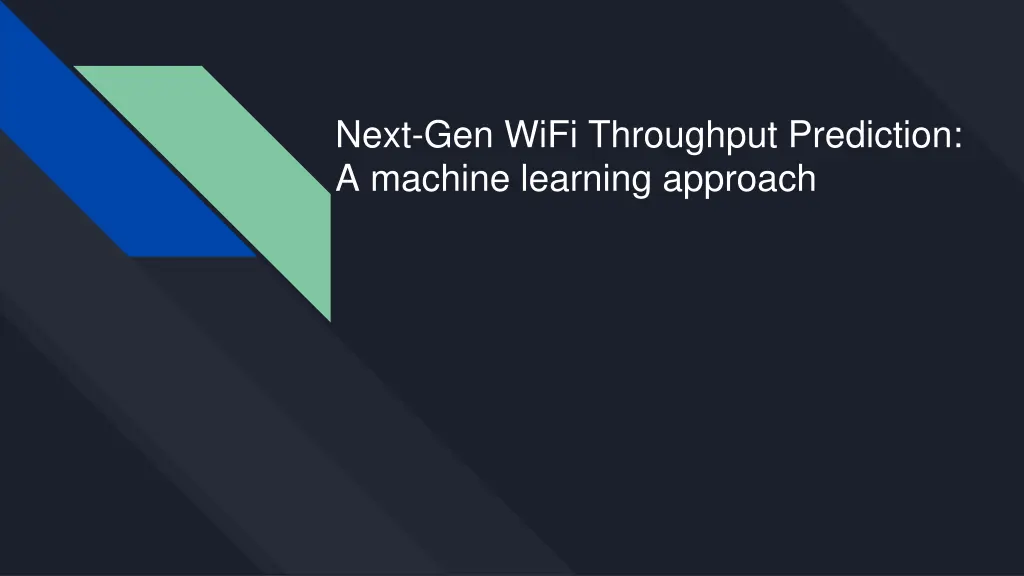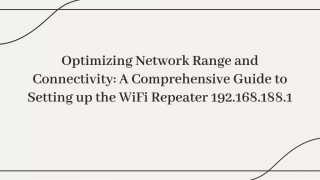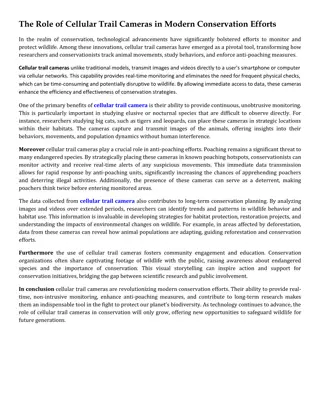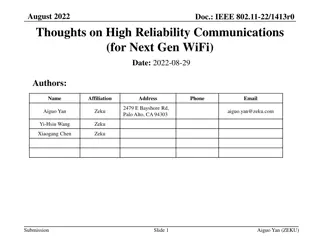
Enhancing WiFi Throughput Prediction with Machine Learning
Explore a machine learning approach for predicting WiFi network throughput by using a synthetic dataset from multiple WLAN deployments. The process involves data preprocessing, feature engineering, and model development to achieve accurate predictions. Transform datasets, create new features, and analyze signal strengths between access points and stations to improve throughput estimation.
Download Presentation

Please find below an Image/Link to download the presentation.
The content on the website is provided AS IS for your information and personal use only. It may not be sold, licensed, or shared on other websites without obtaining consent from the author. If you encounter any issues during the download, it is possible that the publisher has removed the file from their server.
You are allowed to download the files provided on this website for personal or commercial use, subject to the condition that they are used lawfully. All files are the property of their respective owners.
The content on the website is provided AS IS for your information and personal use only. It may not be sold, licensed, or shared on other websites without obtaining consent from the author.
E N D
Presentation Transcript
Next-Gen WiFi Throughput Prediction: A machine learning approach
Table of content Problem statement Data preprocessing Feature engineering Model conclusion
Problem statement The goal is to use machine learning to predict the achievable Wi-Fi network throughput for a given subset of access points (APs) transmitting simultaneously using Coordinated Spatial Reuse (c-SR) in the Multi-Access Point Coordination framework. A synthetic dataset has been provided with data from multiple random WLAN deployments.
Data The provided dataset includes multiple entries for different Wi-Fi network deployments, which vary in device position and include the RSSI matrices and the subset of randomly selected APs for each deployment.
Data preprocessing The primary task is to transform datasets by removing the RSSI matrix and adding new features as columns, labeled APi_STAj, to represent the signal strength between access points and stations. This process will result in 5 unique datasets based on different topologies, which will later be merged into a single dataset. To create these new features, the APi_STAj value is considered only if the corresponding AP is active and the nearest station's AP is also active; otherwise, the value is zero.
The next step involves transforming all datasets to match the shape of the dataset with a 9-station topology. Consequently, all stations linked to a specific AP can be treated as a single station, with the main difference being the RSSI between the AP and the station. the 5 topologies are combined into train and test datasets We ended up with the following features, These features can be categorized into the following groups: Access Points (APs): AP1, AP2, AP3, AP4, AP5, AP6, AP7, AP8, AP9 Deployment: Deployment Signal Strength between Access Points and Stations (RSSI Values): AP1_STA1, AP1_STA2, ..., AP9_STA9 (total of 81 features) Throughputs: TP1, TP2, TP3, TP4, TP5, TP6, TP7, TP8, TP9.
Feature engineering We consider this hypothesis from the perspective of a particular station: the signal emitted by its associated access point (AP) can be considered the desired or useful signal. signals emanating from other APs that are active at a given transmission opportunity (TXOP) can be regarded as interfering signals. the global interfering signal at the station is the sum of all interfering signals from various APs, expressed in terms of power(Watt). Based on this hypothesis, we can create 9 separate datasets i.e each AP can be treated separately. Useful features can now be created, namely: difference: Useful signal minus interfering signal division: Useful signal divided by interfering signal.
For example this is how the first 10 rows data for AP1 would look like:
Machine learning model: Key Simplification: Problem transformed from regression to classification. Reason: 13 unique throughput values identified. Model: Xgboost with the following hyperparameters: Number of iteration: Default (100). Learning rate : 0.2 Max depth: 15 Number of classes: 13
Simpler model: decision tree The classification problem seems to be so simple so we opted for a simpler model for faster training. We chose to work with a decision tree model with default hyperparameters. Model performance:
Conclusion Problem simplified by turning it into a classification problem with 13 unique throughput values. New features created to represent the difference and division between useful and interfering signals. Simpler model chosen for faster training, resulting in an efficient and effective solution for the given challenge. Model performance: 100% accuracy.






















